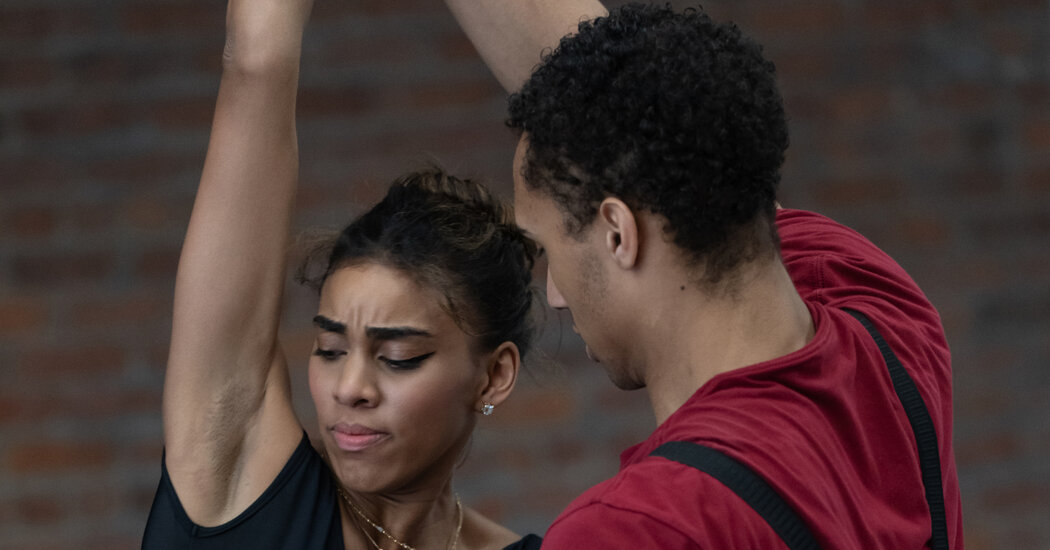Putting a program of ballets together is like composing a delicious meal. An enticing beginning, something more substantial to follow, and a finale that leaves ’em wanting more. Creating that perfect menu is one of the most central and difficult tasks for a ballet company’s artistic director, who must also consider how the mix of works will develop and challenge the dancers technically and artistically.
“I love thinking about all this,” said Robert Garland, the artistic director of Dance Theater of Harlem, which will perform at New York City Center from Thursday to Sunday. “No one really talks about it, but it’s one of the most important parts of the job.”
Garland, who danced with Dance Theater of Harlem from 1985 to 1998, was the company’s resident choreographer before taking the helm in 2023. For his second New York season, he has programmed George Balanchine’s “Donizetti Variations,” William Forsythe’s “Vertiginous Thrill of Exactitude,” a new work (“Passage of Being”) by Jodie Gates, and two of his own pieces, “The Cookout” and “Return.”
His intent with the programming, he said, goes back to his first experience of seeing Dance Theater of Harlem as a young boy in Philadelphia in the 1970s. “There was “Forces of Rhythm” by Louis Johnson, which mixed ballet and funky movement, and then the “Corsaire” pas de deux” — a swashbuckling display of balletic virtuosity. “I was just blown away that you could move from one to the other.”
He added, “What I always want is for the works to speak back and forth; to have a conversation within the dancers’ bodies.”
Balanchine is always part of that conversation at Dance Theater of Harlem, Garland said, since Arthur Mitchell, who founded the company with Karel Shook, was the first Black principal dancer at the Balanchine-led New York City Ballet, and brought many of his mentor’s ballets into the repertoire.
And besides, Garland said, “he is my choreographic hero.”
For this season, Garland decided on the effervescent “Donizetti Variations” (1960) set to music from the opera “Don Sebastian.” The ballet, in 13 sections, is essentially a long string of enchanting divertissements, asking for an unobtrusive allegro virtuosity from a principal couple and an ensemble of six women and three men.
“It’s a really challenging ballet,” said Kyra Nichols, a former principal dancer with New York City Ballet, who staged the work on Dance Theater of Harlem. “It’s fast, with a lot of jumps and technical difficulties that aren’t obvious. And it must look effortless and fun.”
A challenge for the dancers, Nichols said, was to move with speed and attack but also know how to “vary the texture; it can’t all be the same intensity.”
Kouadio Davis, who is performing in all the ballets over the course of the three-day City Center run, said he hadn’t initially understood why Garland had chosen the very classical, prettily balletic “Donizetti.” But after learning the work, “it just clicked,” he said. “It’s the perfect Balanchine piece for us right now, technically challenging in a way we are ready for.”
The choice of Forsythe’s “Vertiginous,” set to the finale of Schubert’s “Symphony No. 9,” was a way of building on skills the company had developed through dancing his “Blake Works IV (The Barre Project)” last year. Forsythe, an American choreographer, has explored ballet’s principles and techniques in a way that has helped to shape classical dance over the past few decades.
“I really appreciate the way Mr. Forsythe and Mr. Balanchine use rhythm and syncopation; it’s a very American approach to musicality,” Garland said. “Forsythe really opens up the Schubert score to the ear of the dancer; it teaches them a kind of freedom within the constraints.”
“Vertiginous” was originally choreographed in 1996 for three women and two men. But for Dance Theater, Forsythe asked Gates to create a new version, using six women alongside the male pair. A sparkling display of the traditional properties of ballet — classical technique, tutus, pointe shoes, a friendly display of formal manners — “Vertiginous” is also notoriously tricky.
“One ballerina said she would rather go through childbirth again!” Forsythe said of a previous staging. “It has such high technical demand in the musicality, the detail and coordination, and it shifts dramatically from step to step at such high speed that not only is your body challenged, but your mind, too.”
“It was time to kick it up a notch,” Garland said.
“Vertiginous,” Davis said, is a showcase for the dancers. “It’s so technical: It starts in fifth position, then a plié, the first step you do in ballet class, and it’s like you are going through the whole class, showing what you know about ballet.” He added, “Forsythe told us, ‘The dancer loves to untie little knots.’ In his pieces, you can always find a new way to get the knot out with more risk, or excitement or cool.”
The final piece of the programming puzzle, Garland said, was commissioning a new work from Gates. “Having a new piece created on you is the pinnacle of artistic expression,” he said.
He chose Gates, he said, partly because she had an existing relationship with the dancers from staging the Forsythe pieces and knew their capabilities. And, he said, “she is one of the few women making classical dance.”
“Passage of Being,” set to three compositions by Ryan Lott, will be performed after “Vertiginous,” and is very different in tone, Gates said. “I’m very attracted to movement with circular momentum, looping, threading, unthreading.”
The work, she added, “may appear balletic in nature, sometimes even romantic, but it’s important to me that I continually empower the women, ask them to be an equal partner in duet work and have autonomy.”
Alexandra Hutchinson, a performer in the work, said Gates “asks us to think about connection and relationship rather than how the line looks; that’s the challenge.”
As for his own works at City Center, Garland said they were essentially “about Black joy, coming together.”
“This program,” he continued, “gives me what Arthur Mitchell gave me in the ’70s — that all these things can exist in the same space and nurture one another.”
Or as Davis put it, “I think Mr. G has a plan.”
#Dance #Theater #Harlem #Robert #Garland #Plan










